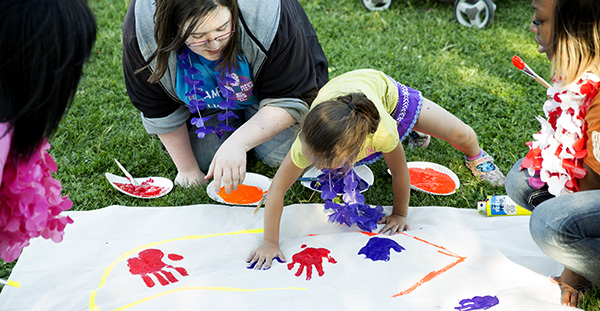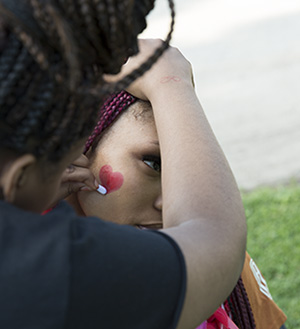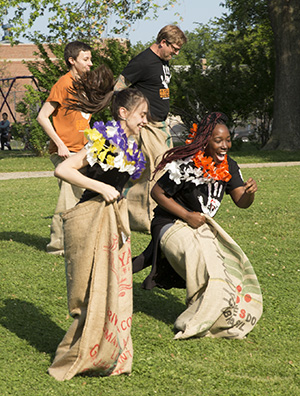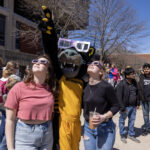
A group of Bay View High School students set out to map a neighborhood and ended up bringing the neighborhood together.
Their project grew out of a partnership involving the high school, Milwaukee Public Schools, the University of Wisconsin-Milwaukee’s Center for Urban Initiatives and Research (CUIR), and local community organizations Serve2Unite and Arts@Large.
The project began when a group of MPS administration staff, CUIR staff and community leaders got together to discuss a hands-on project that would focus on community engagement while introducing students to research and data collection. Bay View’s principal, Aaron Shapiro, and teacher Katrina Halsey immediately saw the value of this idea and offered four of Halsey’s world geography classes as a pilot.

The UWM CUIR team, Bay View teachers, Serve2Unite staff and MPS’s Service Learning Coordinator worked with 130 students in Halsey’s classes on the Youth Community Mapping/Service Learning project from January to June 2014.
Community mapping is an applied research method used to study a neighborhood closely to identify its assets and challenges, says Terry Batson, acting director of CUIR. “It’s a good way to engage young people in higher-level thinking and problem solving. It’s also a way to help them engage in research in a way that’s interesting to them.”
“We wanted to get them to look at their own neighborhoods with a critical eye,” adds Jessica Bizub, a researcher with CUIR.
The UWM researchers provided the students with training on how to collect data and build a community map.
After hearing presentations from community organizations in the Layton Boulevard West neighborhood, the students worked in small groups to identify neighborhood challenges that could be mapped.
They decided to look at four key concerns:
- Potholes
- Youth-friendly places
- Walking safety
- Trust

“We were a little skeptical that the students would be able to map something as vague as trust,” says Batson.
But the students decided that if a lot of people had alarm systems, bars on windows and neighborhood watch signs, all of which could be mapped by address, it could be seen as a sign of concern for safety, but could also represent a lack of trust in their neighbors.
With the help of a GIS (Geographic Information System) mapping specialist at CUIR, the young people worked in nine teams, with three mappers.
One mapped trust, another potholes and the third, youth-friendly places. Then, all the team maps were combined, one for trust, one for potholes and so on.
The trust map had an extraordinary number of dots at addresses, says Batson. “It was loaded with dots in all areas, but particularly near National Ave. “
There were very few potholes on the full neighborhood map and very few youth-friendly places on the youth-friendly map. Potholes clearly were perceived as a problem by community organizers, but the data indicated they were not, according to Batson.
The students discussed the lack of youth friendly places as a problem, but decided to focus on trust because they could have a response to it in the form of a service learning project, Batson adds.
With the help of Serve2Unite, an organization which brings together young people from different religious and cultural backgrounds to build inclusive, compassionate, nonviolent climates in their schools and surrounding communities, the young people planned a community block party. They passed out flyers in the neighborhoods and at local schools, inviting everyone.
The event, held June 6 at Burnham Park under sunny skies, brought together families and neighbors of all ages to enjoy face painting, food and games, as well as the opportunity to meet a Milwaukee Police Department Officer. Together, the neighbors created a colorful mural incorporating handprints from everyone who attended. The entire event was organized and supervised by the students. Arts@Large, which had donated the cameras for the mapping project, also donated Serve2Unite t-shirts for the teens.
“The neighborhood is safer if people trust each other,” says Jorge Herrera, one of the Bay View students. “We wanted to try to bring them together to make new friends and get to know each other,” added Fabian Santana, another of the students involved.
“You might only know your neighbor, Miss Smith, as the old lady with the cats,” explains Herrera, “but if you get to know her, you might find out she also bakes wonderful cookies.”
Everyone involved, especially the youth, feel that the project was so successful they are hoping to expand it to more classes and throughout the year next year, according to Batson. CUIR staff will be working with Bay View teachers and the MPS Service Learning Coordinator, Sarah Kubetz, during the summer to plan a longer-term, more comprehensive mapping project in the high school’s Bay View neighborhood, with the goal of improving relations between the community and school.
“It was hard work getting ready,” says Jamie Davis, a Bay View student, “but it’s nice. …It’s pretty cool bringing people together. That’s what this was supposed to be about.”
“This project was a service-based learning exercise tied to the curriculum and it’s been phenomenal,” said Steven Vande Zande, a program implementer based at the school. “At every step of the way, the students dreamed big and stepped up and said yes to what needed to be done.”
“The opportunity that this project represents from a positive youth development perspective is that young people benefit tremendously when they feel included, connected, and valued by their community,” says Quinn Wilder, senior outreach specialist and program manager of the Youth Work Learning Center at the School of Continuing Education. The center was part of the original meetings with MPS and CUIR to design the framework for the project and identify partners, and met with Bay View staff and students to help identify issues and get oriented to the mapping process.
“One of our goals is to get youth more involved in their communities and schools,” says Pardeep Kaleta one of the co-founders of Serve2Unite. “This project really got them inspired to be involved.”






